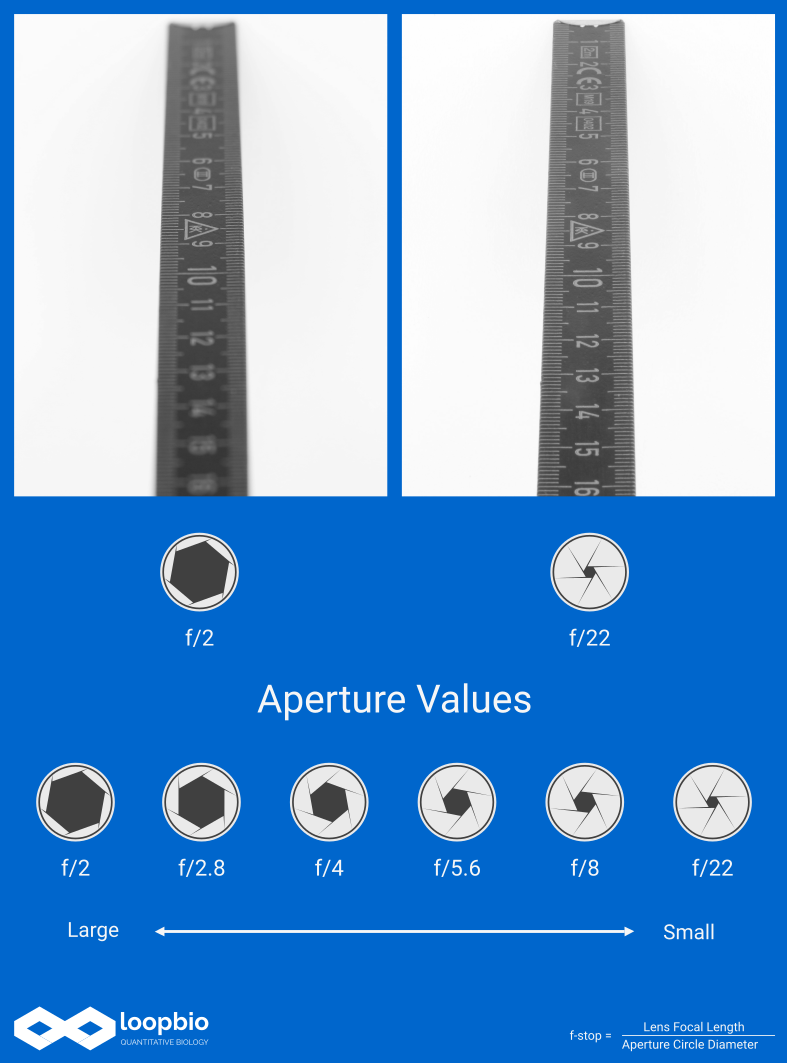Optics - Introduction
The optics (synonym with lens) are an essential part of the imagining system. Selecting the best lens for a certain application is essential. Contact us for help finding the best lens for your Motif recording system.
This section provides you with an overview of the different parameters of a computer vision lens (or lens in general) and puts them in context with other aspects such as the camera and lighting.
Lens Parameters
Focus
The focus of a lens must be adjusted for the Working Distance (WD) and relates to the Field Of Depth (FOD).
Focal Length
The focal length of a lens is given in mm and describes how narrow the angle of view will be ("how zoomed in").
Fixed Focal Length Lens
The focal length of a fixed focal length lens can not be changed. For achieving a larger Field of View (FOV) the WD must be increased (e.g. by moving the camera further away from the area of interest). For imaging from a smaller area, the WD needs to be reduced.
Fixed focal length lenses usually provide a higher image quality and are more price efficient than varifocal lenses
Varifocal Lens
The vocal length of a varifocal lens can be changed (focal length from x to y mm). This allows adapting the FOV and does not required moving the lens closer or further away for that purpose. However, changing the focal length requires adjustment of the focus.
Varifocal lens area also often refereed to as zoom lenses.
Aperture
The aperture, also called the iris, determines many important parameters of the lens:
- over all light that can pass (brightness)
- the sharpness of the image (Depth of Field)
- ability to produce contrast at a given resolution

Image on the left: A shallow Depth Of Field, the aperture was large and the exposure time was short. Image on the right: A deep Depth Of Field, the aperture was small and the exposure time was very long
- large aperture -> bright image -> shallow Depth Of Field
- small aperture -> dark image -> deep Depth Of Field
Info
The notation of the aperture vales on lenses differ greatly by model and manufacturer. The values written on the side of a lens most often refer to the "Aperture Circle Diameter".
Note
- A large aperture is equal to an "open aperture"
- A small aperture is equal to a "closed aperture"
Balancing Depth of Field and brightness is a big challenge as adding more is not always possible.
Working distance (WD)
The distance from the lens to the object. For some lenses an optimal WD is specified. The WD, in combination with the focal length of the lens and the sensor size of the camera define the "Field of View"
Minimal Operating Distance (MOD)
Also refereed to as "Minimal Focus Distance (MFD)" or "Minimal Working Distance (MWD)".
Optimal Operating Distance
Some lenses have an optimal operating distance specified. At this distance the best imaging results will be achieved.
Image Circle
Each lens has a maximal image circle. This diameter describes how large a camera sensor can be without vignetting.
Lens Resolution
Each lens has a certain resolution and must be matched to the camera resolution and to the size of the pixels of the camera sensor.
Distortion
Every lens has some distortion. Some aspects of distortion can be corrected by calibrating the intrinsic parameters of the lens. Loopy provides several automated algorithms to apply such correction to videos.
Filtering
Most lenses can be equipped with optical filters. Many different filters and filter technologies exist and choosing the right one depends on the specific requirements.
Info
Most color cameras have a IR Cut Filter built in by default, more.
IR Pass Filter
For many applications IR lighting is required. In addition to IR lighting, an IR long pass or IR band pass filter can be used on the camera. This filter blocks visual light and only transmits IR light. This allows to separate the visual spectrum (e.g. used to stimulate the model organism, or just for introducing a light - dark cycle) from the imaging spectrum. Switching on and off visual lights will not influence the image captured by the camera.
Info
Using IR light for illumination in combination with an IR pass filter requires a camera sensitive to the IR wavelength used. Most grayscale cameras, and some color cameras can be used.
Fluorescent Filter
Emission filters selected for specific fluorophores can be used in combination with color or grayscale cameras.
Lighting
IR Light
Not all lenses are suitable for being used in conjunction with IR light. For better imaging results the lens should be IR-corrected and should have a "broad-band" coating that transmits IR light.
read more about IR lighting.
Chromatic Aberrations
Lateral color shift and chromatic Lateral color shift are the 2 fundamental component of chromatic aberration.
Lateral Color Shift
This means, that a the different color components (red, green, blue) of a single small white point will end up in slightly different pixels on the camera sensor (rainbow effect). This effect becomes stronger the further away from the center of the image a point is located.
Focal Shift
Different wavelengths have different focal points. Focusing the lens on an object illuminated with long wavelength light (e.g. red or IR850nm) may result in an, out of focus, image with a shorter wavelength light (e.g. green or blue) used.